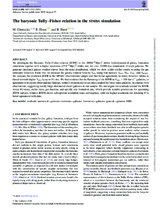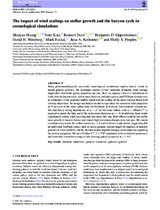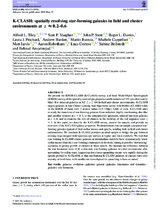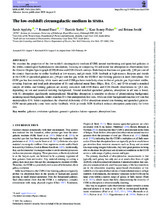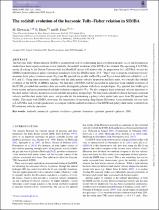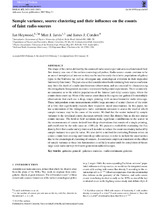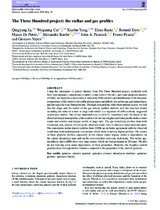Browsing Faculty of Natural Sciences by Subject "Galaxies: general"
Now showing items 1-7 of 7
-
The baryonic Tully–Fisher relation in the SIMBA simulation
(Oxford University Press, 2020)We investigate the Baryonic Tully–Fisher relation (BTFR) in the (100h−1Mpc)3SIMBA hydrodynamical galaxy formation simulation together with a higher resolution (25h−1Mpc)3SIMBA run, for over 10 000 disc-dominated, H I-rich ... -
The impact of wind scalings on stellar growth and the baryon cycle in cosmological simulations
(Oxford University Press, 2020)Many phenomenologically successful cosmological simulations employ kinetic winds to model galactic outflows. Yet systematic studies of how variations in kinetic wind scalings might alter observable galaxy properties are ... -
K-CLASH: spatially resolving star-forming galaxies in field and cluster environments at z ≈ 0.2–0.6
(Oxford University Press, 2020)We present the KMOS-CLASH (K-CLASH) survey, a K-band Multi-Object Spectrograph (KMOS) survey, of the spatially resolved gas properties and kinematics of 191 (pre-dominantly blue) H α-detected galaxies at 0.2 ≲ z ≲ 0.6 in ... -
The low-redshift circumgalactic medium in SIMBA
(Oxford University Press, 2021-08)We examine the properties of the low-redshift circumgalactic medium (CGM) around star-forming and quenched galaxies in the SIMBA cosmological hydrodynamic simulations, focusing on comparing H I and metal line absorption ... -
The redshift evolution of the baryonic Tully-Fisher relation in SIMBA
(Oxford university press, 2021)The baryonic Tully–Fisher relation (BTFR) is an important tool for constraining galaxy evolution models. As 21-cm HI emission studies have been largely restricted to low redshifts, the redshift evolution of the BTFR is ... -
Sample variance, source clustering and their influence on the counts of faint radio sources
(Oxford University Press, 2013)The shape of the curves defined by the counts of radio sources per unit area as a function of their flux density was one of the earliest cosmological probes. Radio source counts continue to be an area of astrophysical ... -
The three hundred project: The stellar and gas profiles
(Oxford University Press, 2020)Using the catalogues of galaxy clusters from The Three Hundred project, modelled with both hydrodynamic simulations (GADGET-X and GADGET-MUSIC), and semi-analytical models (SAMs), we study the scatter and self-similarity ...

